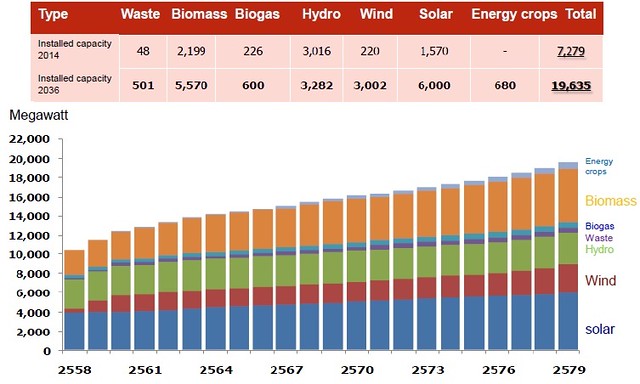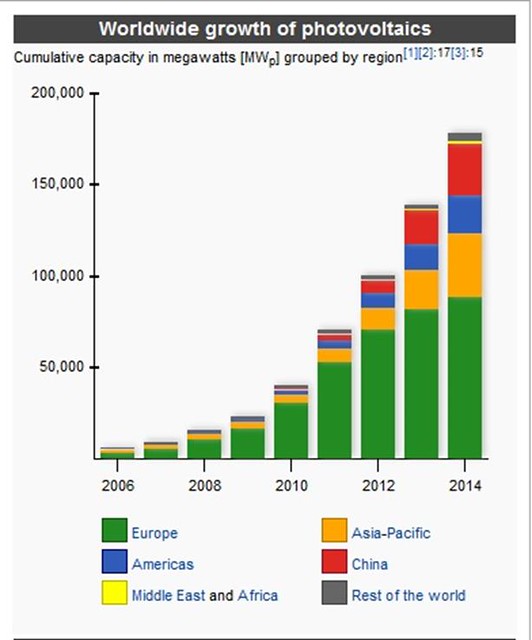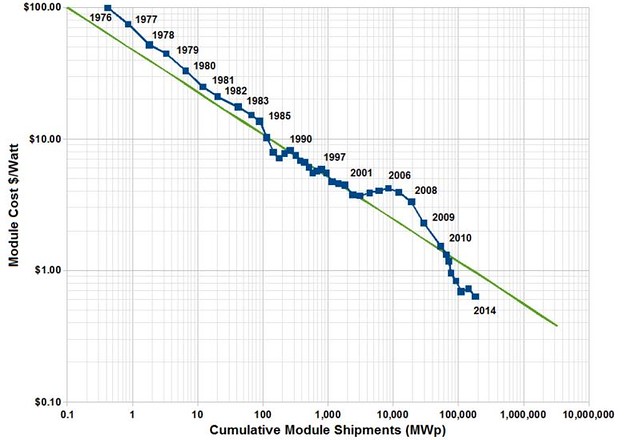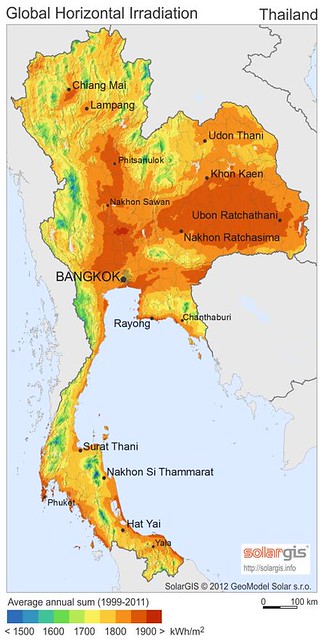One of the downsides of authoritarian military dictatorships is that the public has little influence on politically important issues, such as energy policy. No major Thai daily newspaper supports coal, and they regularly carry articles lobbying against a coal-fired future (e.g., see this recent lead opinion editorial in The Nation). Moreover, the public regularly protest new coal-fired power stations, as in these recent articles covering the proposed coal-fired power-plants in the Thepa District of Songhkla and in Krabi.
One reason for this opposition is that the Thai public is relatively well informed about coal-related problems such as global warming, mercury poisoning, and 1,550 premature deaths from particulates, as well as the destruction of the environment and people’s livelihoods during the mining process. The other reason appears to be religious – coal mining and coal-fired power stations do not pass the ‘What would Lord Buddha do?’ test.
These sentiments can, and should, be harnessed by Thailand’s emerging New Left, i.e., the New Democracy Movement, the Commoners’ Party, and other radical-to-moderate social democrat organizations. In fact, maybe only the New Left can implement an alternative energy policy, as the two degrees’ increase in global temperatures since industrialization comes from a neo-liberal mind-set which does not adequately internalize environmental costs.
In this neo-liberalism paradigm, the 1% of humanity who actually rule the planet and head the world’s industries simply will not be affected by global climate change. As the super-rich own more than the other 99% combined, rising sea levels simply mean they will re-locate their beach-side mansions 10 meters further inland or take to one of their multi-hundred million dollar yachts. Or, should the gross wealth inequality finally cause civil unrest, they can flee to already-prepared bolt-holes in New Zealand.
So, what kind of energy policy could Thailand’s New Left campaign on? Thailand actually has a reasonably good overview of energy requirements. The Ministry of Energy has an Integrated Energy Blueprint covering five areas, the Energy Efficiency Development Plan, the Power Development Plan, the Alternative Energy Development Plan, the Gas Roadmap, and the Oil Roadmap. For the latter two, the main emphasis is reducing the dependence on natural gas, increasing the use of biofuels, and removing the subsidy on fossil fuels.
However, the Integrated Energy Blueprint has some severe blind spots in its vision. It does not, for example, factor in the fact that 2016 will see the launch of mass electric road transport in the form of the GM Bolt – the world’s first mass-produced electric vehicle. Nor is there any appreciation of the growing revolution in battery technologies, where we are beginning to see the potential for innovations in the lithium-ion battery arena, such as all-climate lithium-ion batteries and lithium superoxide batteries, which have five times the energy storage density of conventional lithium ion batteries. In other words, Thailand lacks an ‘Electric Roadmap’, one with clear incentives for transitioning to electric cars and for employing new battery technology. Considering the size of Thailand’s car industry, this is a huge oversight.
The other problem is the coal situation. The Integrated Energy Blueprint and related plans all see imported coal, using ‘clean coal technology’, meeting 20% of the energy mix by 2030, with another 5% of coal produced locally. Combined with another 15-20% imported hydro and gas from neighbouring countries, up to 40% of Thailand’s energy mix could come from imports. This makes a mockery of the Thai military government’s claim to be promoting energy security through self-reliance.
Then there is the clean coal technology itself. The effects of the economics of clean coal technology can be seen in one of Thailand’s close neighbours – China. This is what the economics of clean coal technology have done to China:

The economics of clean coal technology in Beijing
That's right. Clean coal technology is not being used in China, the main reasons being it is a) experimental and b) too expensive. Clean coal implies capturing all the ingredients for acid rain, such as sulphur dioxide and nitrogen oxide, as well as carbon dioxide and particulates, together with the treatment of by-products, such as mercury. Worldwide, there are no commercial clean coal reactors; all are only pilot-scale, such as oxy-fuel plants. Two countries making some progress with clean coal are highly developed, which Thailand is not. Sweden, with its Schwarze Pumpe power station, actually stopped carbon capture research because it was too expensive, and in the US, where there are around half a dozen Clean Coal Technology & Clean Coal Power Initiative (CCPI) projects, none of them are fully commercialized.
In contrast, solar is booming in Thailand. Due to feed-in tariffs, tax incentives and energy production payments, the installed solar as of 2015 was a remarkable 2,500MW (estimated) – more than all the rest of Southeast Asia combined. Moreover, with the price of oil low and China’s domestic solar market saturated, China is racing to sell more solar to Thailand. At present, Thailand’s Integrated Energy Blueprint calls for 6,000MW of installed capacity by 2036. However, this is clearly going to be massively exceeded. The research company BMI sees solar expanding by 13.2% per year on average from 2015-2025, i.e., 8,600MW by 2025 alone. If the same rate of increase is extrapolated to 2036, we are looking at around 33,000MW of installed solar - enough to replace coal-fired power plants in Thailand completely.
Thailand’s energy gurus see Thailand’s solar expanding like this:

Expansion of solar capacity predicted by Thailand’s Integrated Energy Blueprint
This is clearly short-sighted. In fact, even the BMI-predicted rate of growth may be low. The worldwide growth of photovoltaics has averaged an annual 40% since 2000, with total installed capacity at 139 GW by the end of 2013. In 2014, the International Energy Agency predicted that, under its "high renewables" scenario – one which is looking increasingly likely due to technology advances and market economics, solar power could supply 27% of global electricity generation by 2050, through a mix of photovoltaic (the main one in Thailand) and concentrated solar power using mirrors. Basically, economies of scale are why historical growth in solar photovoltaics actually looks like this:

Historical growth in solar photovoltaics worldwide (courtesy Wikipedia)
This diagram clearly illustrates Thailand’s energy gurus are not on track when it comes to solar. One way to illustrate to them why solar is taking off, in ways they can understand, is Swanson’s Law, which is the rate of drop in cost of solar photovoltaic over time due to economies of scale and technological development:

Figure 4: Swanson’s Law – The drop in cost of photovoltaic (courtesy Wikipedia)
The fact that Thailand is neglecting solar’s potential is very evident. Thailand is locked into a coal mentality. Coal provides construction companies with large, profitable contracts, keeps the power in the hands of centralized institutions, and is very vulnerable to corruption during the construction process. Solar, on the other hand, can be decentralised, is relatively easy to cost and manage, and has lower associated ongoing maintenance and zero ongoing fuel costs. And, in a semi-tropical country like Thailand, there is huge potential throughout most of the country:

Solar irradiation in Thailand (Courtesy Wikipedia)
To conclude, next time people protest about coal in Thailand, they should also, in a constructive and honest way, provide this vision of an electric and solar future to General Prayut and the bureaucrats at the Ministry of Energy as an alternative. They should point out that solar will make coal-fired power plants obsolete because of lower costs and improvements in battery storage. They should also point out that the paradigm outlined above complements existing low-carbon visions such as the Low-Carbon Society Vision 2030, co-ordinated by Thammasat University's Sirindhorn International Institute of Technology. This vision is one that Thailand’s emerging Centre-Left can and should embrace – and politicize – as it draws a clear line between failed neoliberalist economics regarding energy and an industry-friendly, progressive, technology-based environmentalism.
Prachatai English is an independent, non-profit news outlet committed to covering underreported issues in Thailand, especially about democratization and human rights, despite pressure from the authorities. Your support will ensure that we stay a professional media source and be able to meet the challenges and deliver in-depth reporting.
• Simple steps to support Prachatai English
1. Bank transfer to account “โครงการหนังสือพิมพ์อินเทอร์เน็ต ประชาไท” or “Prachatai Online Newspaper” 091-0-21689-4, Krungthai Bank
2. Or, Transfer money via Paypal, to e-mail address: [email protected], please leave a comment on the transaction as “For Prachatai English”
